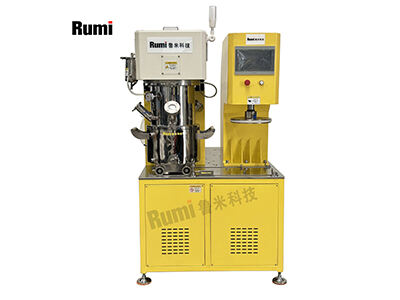دستیابی به همان سطح از ویسکوزیته در طول مخلوط کردن به تضمین کیفیت محصول نهایی کمک میکند، عمدتاً برای مایعات ویسکوز و پلیمرها. برای بسیاری از افراد حل این چالش دشوار است، حاصل آن خواهد بود با خواص محصول ناهمگن و مشکلاتی در عملیات تولید. در اینجا علل و راهحلهای این مشکلات به تأخیر میافتد و مورد بحث قرار میگیرد.
رفع ناکارآمدیهای مخلوط کردن: شناخت اشتباهات متداول در طراحی همزنها برای مایعات چسبناک و مذاب پلیمرها
اگر شما مواد چسبناک را مخلوط میکنید، دستگاه شما باید برای چنین منظوری طراحی شده باشد. مشکلات موجود در طراحی همزنها اغلب باعث ایجاد مشکلاتی در ویسکوزیته مخلوط میشوند. از آنجایی که بیشتر میکسرها مشابه هم هستند، برای مواد با پراکنش بالا مناسب نیستند و این امر مشکلاتی را در مخلوط مناسب و کیفیت بچه مخلوط ایجاد میکند.
معمولاً افراد پره هایی را انتخاب می کنند که بهترین گزینه برای کاربرد خاص خود نیستند. انتخاب اشتباه از لحاظ اندازه پره می تواند باعث کمبود در انرژی گرمایی شود و از خرد شدن مناسب دُمّه ها جلوگیری کند. طراحی پره پره ها تأثیر زیادی روی نوع جریان و نحوه اختلاط مواد دارد.
کالیبراسیون، هندسه روتور-استاتور و کنترل سرعت: روشهای اثباتشده برای بهبود یکنواختی ویسکوزیته در میکسرهای سیارهای و میکسرهای برش بالا
در برابر یکنواختی ویسکوزیته با دقت در کالیبراسیون، شکل جفت روتور-استاتور و کنترل سرعت دستگاه مهم است.
کالیبراسیون
تجهیزات اختلاط باید به صورت مکرر کالیبره شوند. پس از مدتی، عملکرد موتورهای مخلوطکننده و دستگاههای سرعت ممکن است با مشخصات آنها مطابقت نداشته باشد که میتواند نتیجه مخلوط را تغییر دهد. نگهداری و کالیبراسیون مکرر اجازه میدهد تمام قطعات بهصورت مطلوب کار کنند و هر بار نتیجهای یکسان و قابل اطمینان برای اختلاط فراهم شود.
هندسه روتور-استاتور
طراحی واحدهای مخلوطکننده باید به گونهای باشد که اطمینان حاصل شود ویسکوزیته در یک میکسر با سرعت بالا نیز به خوبی پایش شود. فاصله بین روتور و استاتور، حجم دندانهها و نحوه قرارگیری آنها در تعیین این نقش دارند که سیال چگونه و با چه سرعتی مخلوط شود. در مورد میکسرهای سیارهای، مهم است که اتصالات مخلوطکننده به گونهای تنظیم شوند تا اطمینان از مخلوط شدن کامل مواد در طول فرآیند فراهم شود.
ایجاد هندسه مناسب برای مخلوط کردن با توجه به ویسکوزیته و رئولوژی ماده میتواند عملکرد را افزایش دهد. محاسبات انجام شده با استفاده از CFD میتوانند به پیشبینی و تنظیم جریان داخل میکسر کمک کنند و اطلاعات مفیدی برای این منظور فراهم نمایند.
کنترل سرعت
یکی دیگر از موارد اصلی که باید در هنگام مخلوط کردن با ویسکوزیته بالا توسط شرکت شانگهای رومی الکترومکانیکال تکنولوژی به آن توجه شود، نحوه کنترل سرعت است. اگر مخلوط کردن با سرعت نادرستی انجام شود، یا هوای زیادی به مخلوط وارد میشود یا اینکه اجزای مختلف در فواصل دورتری قرار میگیرند. از آنجایی که مخلوط به طور مداوم در حال تغییر است، پارتیشنهای محرک به تغییر سرعت میکسر کمک میکنند تا همواره نیروهای برشی صحیح به کار گرفته شوند.
یک فرآیند سفارشی برای مخلوط کردن اجازه حفظ نتایج تولید را میدهد و محصولات چسبناک و با کیفیتی را فراهم میکند.
نتیجه گیری
لازم است عوامل مهم طراحی میکسر و نحوه اطمینان از ثابت ماندن مخلوط در طول فرآیند مخلوط کردن از نظر ویسکوزیته و ذوب پلیمر را در نظر گرفت. اگر تولیدکنندگان مشکلات معمول همزن را به درستی حل کنند و کنترل دقیق از تنظیمات پیشرفته، انطباق هندسی و سرعت چرخشی را اعمال کنند، نتایج مخلوط آنها به مراتب بهتر خواهد بود.
هنگامی که از یک روش اختلاط خاص برای مواد غلیظ استفاده میکنید، میتوانید اطمینان حاصل کنید که محصولات شما از کیفیت بالایی برخوردار هستند و کارایی فرآیند افزایش مییابد. به کارگیری این راهکارها کنترل بیشتری را برای اپراتورها فراهم میکند، به طوری که هر دسته تولیدی همچنان از کیفیت لازم مورد نیاز تولیدکنندگان پشتیبانی میکند.
 EN
EN
 AR
AR
 BG
BG
 HR
HR
 CS
CS
 DA
DA
 NL
NL
 FI
FI
 FR
FR
 DE
DE
 EL
EL
 IT
IT
 JA
JA
 KO
KO
 NO
NO
 PL
PL
 PT
PT
 RO
RO
 RU
RU
 ES
ES
 SV
SV
 TL
TL
 ID
ID
 LT
LT
 SR
SR
 SK
SK
 SL
SL
 VI
VI
 HU
HU
 TH
TH
 TR
TR
 FA
FA
 MS
MS
 BE
BE
 IS
IS
 AZ
AZ
 BN
BN
 EO
EO
 LA
LA
 MN
MN



